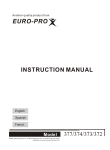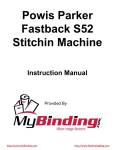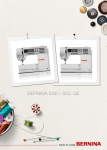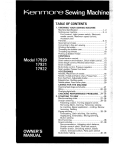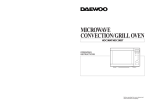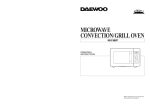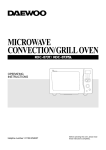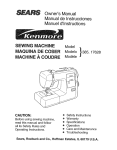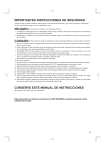Download Euro-Pro 374 Instruction manual
Transcript
Another quality product from EURO-PRO TM INSTRUCTION MANUAL English Spanish French Model 377/374/373/372/372H EURO-PRO Operating LLC, 94 Main Mill Street, Door 16, Plattsburgh, NY 12901 4400 Bois Franc,St. Laurent, QC,H4S 1A7 When using an electrical sewing machine, basic safety precautions should always be followed, including the following. Read all instructions before using this sewing machine. This sewing machine is designed for household use. DANGER- TO REDUCE RISK OF ELECTRIC SHOCK: A sewing machine should never be left unattended when plugged in. Always unplug this sewing machine from the electrical outlet immediately after using and before cleaning. Warning -To reduce the risk of burns, fire, electric shock or injury to persons... 1. Do not allow to be used as a toy. Attention is necessary when this sewing machine is used by or near children. 2. Use this sewing machine only for its intended use as described in this manual. Use only attachments recommended by the manufacturer as contained in this manual. 3. Never operate this sewing machine if it has a damaged cord or plug, if it is not working properly, if it has been dropped or damaged, or dropped into water. Return the sewing machine to the nearest authorized dealer or service center for examination, repair,electrical or mechanical adjustment. 4. Never operate the sewing machine with any air openings blocked. Keep ventilation openings from the sewing machine and foot control free from the accumulation of lint, dust, and loose cloth. 5. Never drop or insert any object into any opening. 6. Do not use outdoors. 7. Do not operate where aerosol spray products are being used or where oxygen is being administered. 8. To disconnect, turn all controls to the off O¡± position, then remove plug from outlet. ¡± 9. Do not unplug by pulling on cord. To unplug, grasp the plug, not the cord. 10. Keep fingers away from all moving parts. Special care is required around the sewing machine needle. 11. Always use the proper needle plate. The wrong plate can cause the needle to break. 12. Do not use bent needles. 13. Do not pull or push fabric while stitching. It may deflect the needle, causing it to break. ¡± 14. Switch the sewing machine off O ¡±when making any adjustments in the needle area, such as threading needle, changing needle, threading bobbin, or changing presser foot and the like. 15. Always unplug sewing machine from the electrical outlet when removing covers, lubricating, or when making any other user servicing adjustments mentioned in the instruction manual. 16. Always unplug before replacing lamp. Replace bulb with the same rated 15 watts. SAVE THESE INSTRUCTIONS 1 English ¡°± IMPORTANT SAFETY INSTRUCTIONS Contents Principal parts 3-4 How to connect the machine to the power supply 4 How to use the foot control 4 How to replace the sewing lamp 4 Changing the needle 5 Thread and needle chart 5 To select a suitable needle 5 Removing and attaching the presser foot 6 Regulating the thread tension Reverse stitch 6 7 The pattern selector 7-8 Removing the bobbin case and bobbin 8 Winding the bobbin 9 Threading the bobbin case 9 Threading the needle 10 Drawing up the bobbin thread 11 Straight stitch and zigzag stitch 11 Changing sewing direction 12 Fastening seams 12 Triple stretch stitch 12 Tricot zigzag stitch 13 Smocking stitch 13 Overlock stitch 13 Double action stitch 14 Double overlock stitch 15 Sewing buttonholes 14-15 Sewing zippers 15 Hemming 16 Sewing blind hems 16 Sewing embroidery 17 Darning plate 17 Buttons Cleaning the feed dog 17 18 Cleaning the shuttle race 18 Free arm sewing 19 Trouble shooting: causes and remedies 20 2 3 17 4 5 2 PRINCIPAL PARTS ( Model 377 ) 1.Bobbin winder thread guide 2.Thread tension dial 3.Pattern selector dial 15 6 4.Bobbin winder spindle 5.Bobbin winder stopper 6.Balance wheel 14 7 8 16 7.Stitch length dial 8.Reverse button 9.Needle clamp and screw 10.Shuttle cover 13 12 11 11.Presser foot 12.Presser foot thumb screw 13.Needle 14.Screw for face plate 15.Face plate 16.Extension table 17.Stitch display (Accessories storage compartment) 10 9 18 18.Presser foot lifter PRINCIPAL PARTS ( Model 374 ) 1.Bobbin winder thread guide 2.Thread tension dial 3.Pattern selector dial 4.Bobbin winder spindle 5.Bobbin winder stopper 6.Balance wheel 7.Stitch length dial 8.Reverse button 9.Needle clamp and screw 10.Shuttle cover 11.Presser foot 12.Presser foot thumb screw 13.Needle 14.Screw for face plate 15.Face plate 16.Extension table 17.Stitch display 18.Presser foot lifter (Accessories storage compartment) 3 English 1 PRINCIPAL PARTS ( Model 373/372/372H ) 1.Bobbin winder thread guide 2.Thread tension dial 3.Pattern selector dial 4.Bobbin winder spindle 5.Bobbin winder stopper 6.Balance wheel 7.Stitch display 8.Reverse button 9.Needle clamp and screw 10.Shuttle cover 11.Presser foot 12.Presser foot thumb screw 13.Needle 14.Screw for face plate 15.Face plate 16.Extension table 17.Presser foot lifter (Accessories storage compartment) HOW TO CONNECT THE MACHINE TO THE POWER SUPPLY 1.Fit the machine plug into the machine. 2.Plug the power cord to the power supply. Note:*Before plugging in the machine, ensure the voltage and number of cycles indicated, conforms to your electrical power supply. HOW TO USE THE FOOT CONTROL Sewing speed can be varied by the foot control. The harder you press on the controller, the faster the machine runs. Note:*By releasing the controller, the machine stops running automatically. *Before using the machine, practice controlling the speed without threading. HOW TO REPLACE THE SEWING LAMP The sewing lamp is located behind the face plate. Remove the face plate by loosing the screw of the face plate. Bulb type: To remove...Unscrew To replace...Screw Note:*Before replacing a bulb, disconnect the machine from the power supply. *Bulbs are available from sewing machine retailers.(Use a 15-Watt bulb) Caution! Before leaving the machine, changing parts or doing any other work on it, always disconnect the plug from the wall socket. 4 Switch THREADS FABRICS NEEDLE SIZE LIGHT WEIGHT Sheer cottons, Silk, Synthetics, Georgette Fine Silk Fine Cotton Fine Synthetic Fine Cotton Covered Polyester MEDIUM WEIGHT Medium Weight Cottons, Synthetics, Poplin, Velvet, Light Weight Woollens 50 silk 50 to 80 Cotton 50 to 60 Synthetic Cotton Covered Polyester 11 or 14 HEAVY WEIGHT Heavy Weight Cottons, Denim Tweed, Gaberdine, Drapery 50 Silk 40 to 50 Cotton 40 to 50 Synthetic Cotton Covered Polyester 14 or 16 Note: 9 or 11 *In general, fine threads and needles are used for sewing thin fabrics, and thicker threads and needles are used for sewing heavy fabrics, Always test thread and needle size on a small piece of fabric which will be used for actual sewing. *Use the same thread for needle and bobbin. *When sewing stretch, very fine fabrics and synthetics, use a STRETCH needle. The STRETCH needle effectively prevents skipped stitches. *When sewing very fine fabrics, sew over a piece of paper to prevent yarn distortion. CHANGING THE NEEDLE 1. Turn the balance wheel towards you until the needle is in its highest position. 2. Loosen the needle clamp screw by turning its top edge towar ds you. Remove the needle from the clamp. , 3. Place the new needle into the needle clamp with it s flat side f acing away from you. Push the needle up into needle clamp as far as possible. 4. Tighten the needle clamp screw firmly. TO SELECT A SUITABLE NEEDLE (4) Stem stretch needle A number indicating the size of needle is marked on the stem. The higher the number, the thicker the needle. A STRETCH needle is recommended for stretch fabrics. * Do not use any needle which is bent or blunted. 5 (3) English THREAD AND NEEDLE CHART REMOVING AND ATTACHING THE PRESSER FOOT To Remove: 1. Turn the balance wheel towards you until the needle is at its highest position. 2. By lifting the lever on the back of the foot holder, the presser foot will drop off. presser foot lifter 1 Note: *Do not force the presser foot to remove it. To Attach: 1. Place the presser foot so that the pin on the foot lies just under the groove of the foot holder. Lower the foot holder. , 2. When the presser foot lifter is raised youll fin d the presser foot is locked in place. 2 lever groove pin 1 2 REGULATING THE THREAD TENSION Generally, should any tension adjustment be necessary, the adjustment can normally be made by regulating the upper thread tension dial only. Bobbin thread tension has been adjusted at the factory and readjustment is seldom required except for special instances, thread and fabric. Bobbin thread tension is just right when you can pull the thread from bobbin case easily with a little resistance. Thread tension may be adjusted by tightening or loosening the thread tension dial. Properly adjusted thread tension for straight sewing The needle thread and the bobbin thread should interiock in the center of two layers of fabric * How to adjust the bobbin thread tension The needle thread is too tight The needle thread is too loose The bobbin thread appears on the upper surface of the fabrics Loosen the needle thread tension by moving the dial to the lower number To increase tension, turn screw clock wise. To decrease tension. turn screw counterclock wise. The needle thread appears on the underside of the fabrics Tighten the needle thread tension by moving the dial to the higher number Remember the higher the number, the tighter the tension. Correctly balanced tensions for one fabric may not be suitable for another. The required tension depends upon the stiffness of fabric, thickness of the fabric, numbers of layers of fabric being sewn, as well as the type of stitch you are making. It is better to test the stitching on a scrap of the fabric you are using before starting to make a garment. The general range for many fabrics is 3-5. 6 To change the length of the stitches proceed as follows: Tu r n t h e d i a l s o t h a t t h e n u m b e r f o r t h e r e q u i r e d s t i t c h l e n g t h i s a t s e t t i n g m a r k . T h e n u m b e r s i n d i c a t e t h e a p p r o x i m a t e s t i t c h l e n g t h i n m m . Th e s m a l l e r t h e n u m b e r s , t h e s h o r t e r t h e s t i t c h . Model 374 Model 377 setting mark stitch lengths REVERSE STITCH: ( Model EP 377/374/373/372/372H ) Press center of the stitch length dial (reversing button) and hold for reverse stitching. Fabric will immediately start feeding backwards. Release button and machine will resume normal forward sewing. Very useful for fastening ends of seams and darts without having to tie threads, and for strengthening seams. Model EP 377 Model 374 Model 373/372/372H THE PATTERN SELECTOR ( Model 377 ) The desired pattern can be selected by turning the pattern selector dial. The marks on the dial correspond to the patterns shown on the panel respectively, as follows; M( ) straight stitch, middle needle position O( ) straight stitch, left needle position 1-5( 54321) zigzag stitch with variable width A( ) tricot stitch B( ) stretch blind stitch SS C( ) double action stitch D( ) reverse blind stitch automatic buttonhole sewing SS Selecting Stretch Stitch: When sewing stretch stitch, set the stitch length dial at S.S. . When you release the engagement on the dial, the Standard djustment stretch stitch mechanism will be off automatically. M( ) triple straight stretch stitch, middle needle position. O( ) triple straight stretch stitch, left needle Turn the stitch length dial so that the SS mark is uppermost. This is a standard adjustment for most types of fabric. For different types of fabric, adjustment may be necessary. To shorten the stretch stitches, turn the dial slightly towards¡°± To lengthen, turn the dial towards¡°± . On most fabrics, these adjustments allow for various pattern possibilities. When making stretch stitches, the mark ¡°± must always be within the SS range - (see drawing). position. 1-5( 54321) triple zigzag stretch stitch or ric-rac stitch A( ) smocking stitch B( ) C( D( ) double overlock stitch ) overlock stitch fancy stretch stitch or blanket stitch 7 English STITCH LENGTH DIAL ( Model 377 and 374 only ) THE PATTERN SELECTOR ( Model 374) The desired pattern can be selected by turning the pattern selector dial. The marks in the stitch display correspond to the patterns shown on the panel respectively, as follows: A( ) straight stitch, middle needle position B( ) straight stitch, left needle position C( ) zigzag stitch with variable width D( ) tricot stitch E( ) stretch blind stitch F ( ) double action stitch G ( ) reverse blind stitch automatic buttonhole sewing THE PATTERN SELECTOR ( Model 373/372/372H) 1-3 ( ) straight stitch 4-6 ( ) zigzag stitch 7 ( 8 ( ) triple zigzag stretch stitch ) triple straight stretch stitch 9 ( 10 ( ) overlock stitch 11 ( ) tricot stitch 12 ( ) shell stitch ( ) smocking stitch ) automatic buttonhole sewing RE MOVING THE BOBBIN CASE AND BOBBIN 1. Raise the presser foot and turn the balance wheel towards you until the thread takd-up lever is at its highest position. 2. Open the shuttle cover. Open 3. Open hinged latch of bobbin case and pull bobbin case out of machine. Release the latch and the bobbin will fall out. As long as you hold the bobbin case latch open, the bobbin cannot drop out. 8 English WINDING THE BOBBIN 1. Draw thread from spool through bobbin winder tension disc as shown. 2. Pull end of thread through hole in bobbin as shown. 3. Push bobbin winder shaft to far left position, if it is not already there. Place bobbin onto shaft with end of thread coming from top of bobbin. Push bobbin winder shaft to right 1 2 3 4 until it clicks. Hold onto end of thread. 4. Start machine. The thread that is held will snap or may be trimmed with a scissors, Bobbin will cease turning when completely filled. Push shaft to left to remove bobbin. When the bobbin winding is incorrect, release the screw of the upper thread guide and adjust the thread guide up or down until the winding of the bobbin is balanced. bobbin case bobbin THREADING THE BOBBIN CASE Hold the bobbin between the thumb and forefinger of your right hand and pull off about 15cm (6 inches) of thread. 1. Hold the bobbin case in your left hand as shown and place the filled bobbin inside. slot 2. Pull the thread into the slot in the edge of the bobbin case. 3. Now pull the thread under the tension spring and into the thread eyelet. tension spring eyelet To insert the bobbin case and bobbin...... long finger Ensure that about 15 cm (6 inches) of thread extends out of bobbin. Hold the bobbin case so that long finger on case points up. Open the latch of bobbin case. Slip the bobbin case over the center pin of hook and press in place until the long finger of the bobbin case enters the notch entirely to lock the bobbin in place. Release latch and press it down. latch latch 9 notch 1 2 5 A THREADING THE NEEDLE Install the spool pin behind the machine (as shown in fig A ). Place spool on spool pin, with thread coming from the back of the spool. Place the take - up lever 5 in the highest position. 3 B 6, 7, 8 4 fig A 1. Raise the presser foot using the foot lever marked B . 2. Draw the thread through the thread ÙÚ 1 & 2. guides on the top cover as shown in ¢.Fig. B 3. Hold the spool still with right hand, pull the end of the thread between the tension disk as shown in Fig. 3¢. Û 4. Following the slotted threading path, pull the thread down to the thread check spring (inside) and lead it across from left to right. 2 1 5. Pull the thread upward and slip into the slotted hole of thread take-up level from left to fight 5 . 5 6. Draw the thread through guides 6 and 7 , and thread the needle from front to rear 8 , leave the thread about 15cm(6 inches) long underneath the presser foot. 3 6 7 4 10 8 English DRAWING UP THE BOBBIN THREAD 1.Hold the end of the needle thread with your left hand. needle thread 1 2.Turn the balance wheel slowly towards you with your right hand until the needle goes down and comes up. Then stop the balance wheel when the take-up lever is at its highest position. Lightly draw up the needle thread forming a loop with the bobbin thread. 2 3.Puil about 15cm (6 inches) of both threads away from you under the presser foot. needle thread bobbin thread 3 STRAIGHT STITCH AND ZIGZAG STITCH Presser foot Pattern selector Model 377 Model 374 zigzag foot zigzag foot ) or O (for straight gtitch) ) A( 1 - 5 (54321) (for zigzag stitch) C( M( Stitch length dial ( 0.3-4 ) or B (for straight stitch) ( ) (for zigzag stitch) 0.3-4 Model 373/372/372H ) ( ) (for straight stitch) ( ) (for zigzag stitch) - Starting Sewing 1. Be sure both the threads are drawn back under the presser foot. 2. While holding the threads with your left hand, turn the balance wheel toward you to bring the needle into the fabric where you wish to start sewing. 3. Lower the presser foot, and press the speed controller gently, then start sewing slowly. *Sew a few reverse stitches by pushing reverse button for reinforcing the end of seams. *Raise the needle to its highest position before turning the pattern selector dial and stitch width dial. 11 zigzag foot C hanging S ewing Direc tions 1. S top the ma chine , a nd turn the ba la nc e whe e l towa rd you to bring the ne e dle down into the fabric . R a is e the pres s e r foot. 2. P ivot the fa bric a round the ne e dle to c ha nge dire c tion a s de s ire d. 3. L owe r the pre s s e r foot and c ontinue s e wing. F as tening S eams 1. F or fa s te ning the e nds of s ea ms , pre s s in the re ve rs ing button a nd s e w s e ve ra l re ve rs e s titc he s . 2. To re move the fabric , ra is e the pre s s e r foot a nd dra w the fa bric a wa y from you. thre a d c utte r 3. C ut thre a ds on thre a d c utte r a t the re a r of pre s s e r ba r or with a pa ir of s c is s ors . L e a ve a bout 15 cm ( 6 inc he s ) of hre a d ha nging from the ne e dle e ye . T R IP L E S T R E T C H S T IT C H ( Mode l 374/373/372/372H) If you wis h to s e w s tre tc h fa bric s , this is the right s titc h to a void thre a d bre a king. T his is a ls o ve ry s uita lbe for s e a ms tha t ne e d gre a t s tre ngth, e . g. c rutc h s e a ms or poc ke t s e a ms . T R IP L E ZIG ZA G S T R E T C H S T IT C H T R IP L E S T R A IG HT S T R E T C H S T IT C H Presser foot M odel 377 zigzag foot Pattern selector M( Stitch length dial M odel 374 M odel 373/372/372H zigzag foot ) 8( ) Presser foot Pattern selector S .S . Stitch length dial N ote : * U s e a S T R E T C H ne e dle . T he blue tippe d s ha nk ne e dle e ffe c tive ly pre ve nts s kippe d s titc he s . 12 M odel 377 zigzag foot O( ) S .S . M odel 374 M odel 373/372/372H zigzag foot 7( ) S MOC K ING S T IT C H T his s titc h is ve ry s uita ble for da rning te a rs . It c a n a ls o be us e d for re inforc ing s tre tc h ma te ria ls a nd s e wing on fa bric pa rts . W ith a na rrow s trip of fa bric dire ctly unde r the line of ga the ring, s titch ove r the ga the rs . T he de s ign will be a s e rie s of s ma ll dia monds . W he n s mocking a ga rme nt, the s titching s hould be done be fore the pie ce is s e wn into the ga rme nt. M odel 377 zigzag foot Presser foot Pattern selector A( ) 0.3 to 4 S titch length dial M odel 374 M odel 373/372/372H zigzag foot zigzag foot D( ) 11( zigzag foot Pattern selector A( ) - 0.5 to 4 M odel 374 M odel 373/372/372H M odel 377 Presser foot S titch length dial S .S . zigzag foot ) 10( ) - N ote : *U s e a S T R E T C H ne e dle . T he s tre tc h ne e dle e ffe c tive ly pre ve nts s kippe d s titc he s . OV E R L OC K S T IT C H W ith this s e a m it is pos s ible to pre ve nt ra w e dge s , e s pe c ia lly on e a s ilyfra ying fa bric s , with a good-loc king and la s ting edge finis h. M odel 377 Presser foot zigzag foot Pattern selector D( S titch length dial M odel 374 Model 373/372/372H zigzag foot ) 9( S .S . P la c e the fa bric unde r the pre s s e r foot s o tha t the s titc he s a re ma de ove r the e dge . L owe r the pre s s e r foot a nd s ta rt s e wing. G uide the ma te ria l lightly a s s hown. S e w on a pie c e of wa s te fa bric to c he c k the ma c hine s e tting. T he ove rloc k s titc he s a re forme d c orre c tly whe n the ne e dle s e ws to the right a nd N ote : *U s e a jus t mis s e s the fa bric edge . S T R E T C H ne e dle . T he s tre tc h ne e dle e ffe c tive ly pre ve nts s kippe d s titc he s . 13 ) English T R IC OT ZIG ZA G S T IT C H DOUB L E A C T ION S T IT C H DOUB L E OV E R L OC K S T IT C H (Model E P 377 only) T his is a good s tilc h to us e in a tta c hing or binding e la s tic fa bric s a nd s tre tc h la c e , linge rie s tre tc h knit. T he s titc h is de c ora tive a s we ll a s us e ful. U s e this ve rs a tile s titc h to ins e rt e la s tic in ga rme nts . S imply s titc h e la s tic into pla c e , ma king s ure it is e ve nly s pa c e d. To do this , ma rk the c orre c t le ngth pie c e into qua rte rs , the n ma tc h the s e ma rkings with c e nte r front a nd s ide s e a ms . M odel 377 M odel 374 Presser foot zigzag foot zigzag foot Pattern selector C( F( Stitch length dial ) 1 to 2.5 M odel 373/372/372H P re s s e r foot P a tte rn s e le c tor S titc h le ngth dia l ) 1 to 2.5 z igz a g foot C( S .S . ) DE C OR AT IV E E DG ING T urn the ra w e dge unde r 2c m a nd pre s s . P la c e the fa bric right s ide up with the middle of the turnove r unde r the c e nte r of the pre s s e r foot, s o tha t the s titc h s e ws on to the fold a nd jus t ove r the ra w e dge unde rne a th. S E WING B UT TONHOL E S T he built -in buttonhole me c ha nis m of this ma c hine ma ke s it pos s ible to s e w button hole s in a s hort time without turning the ma te ria l. M odel 377/374 Presser foot buttonhole foot A rrow ( S ta rt he re ) M odel 373/372/372H buttonhole foot F oot Pattem selector S le igh buttonhole foot S titch length dial 0.5 to 1 R a is e the foot a nd the ne e dle to its highe s t pos ition. R e pla c e the foot with the tra ns pa re nt buttonhole foot for s e wing buttonhole s . Ma rk the loc a tion a nd the de s ire d le ngth of buttonhole on the fa bric us ing a , pe nc il or ta ilor s c ha lk. N ote : (Model E P 377 and 374 only) *To find the mos t s uita ble s titc h le ngth, it is be tte r to s e w a s a mple buttonhole on a pie c e of wa s te fa bric . * W he n s e wing ve ry fine fa bric s a nd s ynthe tic s , de c re a s e the pre s s ure of foot a nd s e w ove r a pie c e of pa pe r to pre ve nt ya rn dis tortion. * T he ma rk on c oa rs e s titc he s for he a vy fa bric s de ns e s titc he s for light fa bric s the s titc h le ngth dia l s hows a ra nge of buttonhole s e wing. An a djus tme nt c a n be ma de by s e tting the ma rk, a s s hown. * B uttonhole s titc h le ngth is a djus ta ble only on one s ide . 14 ra nge of s titc h le ngth 1. Set the pattern selector at ¡°¡± . Then pass the needle thread throughthe opening in the buttonhole foot and draw both needle and bobbin threads to the left side. Turn the balance wheel towards you until the needle comes to the point (1). 2.Lower the foot and sew slowly until the desired length is sewn, then stop the machine at (2). 3. Raise the needle and set the selector at¡ . Then sew ° ± several stitches of bar tack until the needle is at point (3). E nglis h SEWING BUTTONHOLES (Model 377 and 374) (Model EP 377 and 374 only) 4. Raise the needle and set the selector at¡ then sewthe ° ± right side of buttonhole the same length as the left side of buttonhole. Stop the machine at (4). 5. Raise needle and set the selector at¡ then sew several ° ± stitches of final bar tack. Stop the machine with the needle at point (5). . To lock thre ads, set the pattern selector at ¡ ° B§(zero point of zigzag width). And sew a few stitches. 6. Cut thebuttonhole open carefully using a seam ripper, taking care not to damage the bar tacks. SEWING BUTTONHOLES (Model 373/372/372H) 1. Set the pattern selector at¡°¡± Then pass the needle thread through the opening in the buttonhole foot and draw both of needle and bobbin threads to the right side. Turn the balance wheel towards you until the needle comes to the point (1). 2. Lower the foot and sew slowly until a desired length is sewn, (Model 373/372/372H) then stop the machine at (2). 3. Raise the needle and set the selector at¡°¡± then sew several stitches of bar tack until the needle is at point (3). 4. Raise the needle and set the selector at¡°¡± then sew the left side of buttonhole just as the same length as the right side of buttonhole. Stop the machine at (4). 5. Raise the needle and set the selector at ¡°¡± then sew several stitches of final bar tack. Stop the machine with the needle at point (5). 6. Cut the buttonhole open carefully using a seam ripper, taking care not to damage the bar tacks. Note: To make a heavier buttonhole, sew twice by repeating the same procedure. S E W ING ZIP P E R S Presser foot M odel 377 zi pper foot Pattern sel ector M( S titch l ength di al R a is e the 1 to 4 ) M odel 374 Model 373/372/372H zi pper foot zi pper foot A( ) Z ippe r foot 1-3( ) ta pe E le me nts 1 to 4 foot a nd the ne e dle to its highe s t pos ition by turning the ba la nc e whe e l towa rds you. R e pla c e the foot with the z ippe r F a bric E le me nts foot. 1 . P in or ba s te the z ippe r ta pe to the fa bric a nd pla c e the workpie c e in pos ition unde r the foot. A tta c h s na p on z ippe r foot s o tha t the ne e dle pa s s e s on its S lide r le ft ha nd s ide . * W he n s ta rting s e wing, both ne e dle a nd bobbin thre a ds e nds s hould be put a wa y unde r the foot. 2 . S e w on the right s ide of the z ippe r by guiding Z ippe r te e th E le me nt a s c los e a s pos s ible to the ne e dle drop. B e fore the foot re a c he s the s lide r on the z ippe r ta pe , ra is e the foot a nd ope n the z ippe r by ke e ping the ne e dle in the fa bric . L owe r the foot a nd s e w on the re ma ining of the s e a m, 3 . To s e w the le ft s ide z ippe r c ha nge pos ition of foot to bring the foot to the le ft s ide of the ne e dle . S e w on in the s a me wa y a s you did on the right s ide of z ippe r. 15 Z ippe r foot Ta pe N e e dle F a bric E le me nt S lide r F ia . 1 HE MMING (Model 377 only) P re s s e r foot he mme r foot P a tte rn s e le c tor M( S titc h le ngth dia l ) 1 to 4 hemmer foot R ais e the foot and the needle to its highes t pos ition. R eplace the foot with the hemmer foot. F old over the fabric edge by about 3mm (1/8 inches ) and place it under the foot. S ecure the folded edge with a few s titches . Take out the workpiece and draw the hem into the hemmer foot by pulling on the threads . 3mm Lower the foot and s we the hem. During s ewing, fold the fabric to the left a little and allow it to run into the hemmer foot. Make s ure that the fabric does not move under the right half of the foot. T he fabric mus t be fed into the s croll of the hemmer s ufficiently s o that the workpiece edge runs freely through the groove under the foot. S E WING B L IND HE MS Presser foot Pattern selector S titch length dial (Model 377/374/373/372/372H) M odel 377 M odel 374 blind hem foot blind hem foot B( ) 1 to 3 E( M odel 373/372/372H ( F ig. 1) ,, 4mm ( 1/6 ) ) 1 to 3 1. T urn up the hem to the des ired width and pres s . ( F ig. 1) 2. F old hem back agains t the right s ide of the garment with top edge of hem extending about 4 mm (1/6 inches ) to the right s ide of the garment folded. (F ig. 2) 3. P lace the garment under the foot s o that double-folded edge runs along the hemlguide and lower the foot. S ew s lowly for better control, making s ure the narrow zigzag s titches are s ewn on the hem edge and wide zigzag s titches will jus t catch one thread of folded edge. (F ig. 3) 4. Unfold the (F ig. 4) fabric and you will have a bling ( F ig. 2) G uide a djus ting s c re w( F ig. 1) G uide s titch hem F oide d e dge ( F ig. 3) ( F ig. 4) 16 English SEWING EMBROIDERY Presser foot Pattern selector darning plate ( ) or zig zag embroidery hoop Raise and take off the foot. Place the fabric in embroidery hoop. Place darning plate over needle plate (see below). Lower the presser foot lifter. Hold the embroidery hoop firmly with your hand. While sewing the desired pattern, move the embroidery hoop slowly and do not allow your fingers to get near the needle. *Set the needle thread tension a little looser so that the bobbin thread is not pulled through to the right side of fabric. (See page 13). *It is recommended to mark the required embroidery pattern , on the right side of the fabric with a pencil or tailor s chalk. DARNING PLATE There are a few times when you want to control the feeding of the fabric yourself. Raise needle to its highest position and raise presser foot. Place darning plate over needle plate aligning two pins of darning plate with holes of needle plate. You may then determine the movement of the fabric yourself. See above for embroidery. Thread Shank BUTTONS Model 377 Presser foot Pattern selector Model 374 button foot 1-5(54321) Model 373/372 button foot 4-6( ) Button foot 1. Align two holes of button with slot of presser foot and lower foot to hold the button securely. 2. Turn hand wheel manually until needle point is just above button. 3. Adjust stitch selector so needle enters right hole of button. 4. Turn hand wheel by hand so needle enters second hole. The stitch selector may need to be adjusted again. Stitch a number of times. NOTE: You may find it helpful to use transparent tape to position your button and to keep it in place during sewing. Tear away after stitching. 5. Finish sewing with an extra two inches of thread remaining. Draw these threads to reverse side of garment and tie. Holes of button 17 Sew-through buttons on coats and jackets should nave a thread shank to make them stand away from the fabric. Place a straight pin or sewing machine needle on top of button between the holes, and sew over the pin or needle. Pull thread to back of button and wind around stitches to form a firm shank. Tie thread ends securely. CLEANING THE FEED DOG It is necessary to keep the feed dog teeth always cleaned in order to ensure smooth sewing. 1. Remove the needle and the presser foot. 2. Unscrew the needle plate set screws with a screw driver to take off the needle plate from the machine. 3. With a brush, clean out dust and lint clogged on the feed dog teeth. 4. Refit the needle plate. CLEANING THE SHUTTLE RACE Unplug the machine from the power supply. To remove shuttle: Raise needle to its highest position and remove bobbin case. Turn levers away from shuttle and lift out retaining ring and shuttle, by grasping center pin. Clean the reverse side of feed dog with a small brush. Remove lint and thread from all parts of shuttle and wipe with a lightly oiled cloth. shuttle driver lever lever To reassemble: Hold shuttle by center pin and fit carefully back into shuttle race, forming perfect circle with shuttle driver.. Replace retaining ring polished side out, making sure the bottom pin fits into notch. Lock retaining ring by turning levers back into position, Refit bobbin case with bobbin. shuttle bobbin 18 retaining ring bobbin case English FREE ARM SEWING This sewing machine can be used like a flat bed machine, but easily converts to a free arm machine by removing the extension table. The free arm enables you to sew tubular types of pieces more easily. Just slip the sleeve or pants leg on the free arm as shown above. You will find many uses for this free arm feature such as: 1. Mend elbows and knees of garments more easily. 2. Sew in sleeves more easily. This is especially true when sewing smaller garments. 3. Applique, embroider or hem around edges of cuffs or pants legs. 4. Sew in elastic casings in skirts or pants at the waist line. 19 TROUBLE SHOOTING: CAUSES AND REMEDIES THREAD FORMS LOOPS REMEDY CAUSE Read instructions for regulating needle-and bobbin thread tension Thread machine properly and/or wing bobbin thread correctly Thread tension not properly regulated Needle thread properly threaded and/or bobbin thread not properly wound Thread size not suited to fabric Thread check spring not working properly See Size of needle and thread Have spring replaced SHRINKING OR PUCKERING OF THE SEAM Read instructions for regulating needle-and bobbin thread tensions Read instructions for regulating sewing foot pressure Tension too tight Sewing foot pressure too strong IRREGULAR STITCHES Use top quality threads Re-wind bobbin Needle and bobbin threads of poor quality Bobbin thread unevenly wound MACHINE DOES NOT RUN FREELY AND MAKES A NOLSE Read instructions on how to oil Read instructions on how to clean shuttle race Clean machine carefully and re-oil with top quality oil Loosen tension of drive belt Machine needs oiling Dust and thread in shuttle Wrong oil used, has now clogged machine Drive belt tension too tight TROUBLE SHOOTING: CAUSES AND REMEDIES NEEDLE THREAD BREAKS REMEDY CAUSE Thread properly loosen tension Replace needle Change Have a new spring fitted Insert needle properly Replace Needle not properly threaded Thread tension too tight Something wrong with the needle Thread is too heavy for needle Thread check spring is broken Needle not properly inserted Needle plate, shuttle or sewing foot damaged BOBBIN THREAD BREAKS Wind bobbin correctly Thread bobbin correctly Bobbin thread entangled because of incorrectly wound bobbin Bobbin thread not under tension spring on bobbin case STITCHES ARE LEFT OUT Fit needle properly Replace Replace Needle not properly fitted on needle bar Needle bent or blunt Needle worn NEEDLE BREAKS Replace Fit needle properly Use needle of correct size Do not pull Needle bent Needle not properly fitted Fabric too heavy or too hard You are pulling on the fabric 20 25 YEAR LIMITED WARRANTY EURO-PRO Operating LLC warrants this sewing machine for a period of 25 years from date of the original purchase, to be free of defective parts due to imperfections in the workmanship and materials, subject to the following conditions, exclusions and exceptions. EURO-PRO Operating LLC will, at its option, repair or replace this sewing machine free of charge if it fails to operate according to specifications due to factory defects in materials or workmanship within one year from date of purchase. For 25 years from date of purchase, EURO-PRO Operating LLC will repair or replace defective sewing machine head parts; owner pays for labor charges. The sewing machine must be shipped freight and insurance prepaid to: In U.S. :EURO-PRO Operating LLC, 94 Main Mill Street, Door 16, Plattsburgh, N.Y. 12901 Tel.: (800) 361-4639 In Canada: EURO-PRO Operating LLC, 4400 Bois Franc, St. Laurent, Quebec, H4S 1A7 Tel.: (800) 361-4639 A copy of your sales receipt and $15.95 for handling and return packing/shipping charges must be included.* The electrical equipment (motor, rheostat, control, light, electronic parts etc.) are warranted free from defects in material and workmanship for a period of two years from the date of original purchase. Non-durable parts including, without limitation, needles, belts, bobbins, bulbs, bobbin cases, shuttles, springs, and parts which normally require replacement are specifically excluded from this warranty. This warranty is in effect provided the sewing machine is used only for normal household use by the original purchaser when new, and is given reasonable good care and proper maintenance in accordance with the accompanying instruction book. The manufacturer is not held responsible for damage, normal wear, accident, abuse, neglect, negligence or if the machine has been repaired by unqualified personnel. This warranty is extended to the original purchaser of the unit and excludes all other legal and/or conventional warranties. The responsibility of EURO-PRO Operating LLC if any, is limited to the specific obligations expressly assumed by it under the terms of the limited warranty. In no event is EURO-PRO Operating LLC liable for any indirect, incidental or consequential damages of any nature whatsoever. Some states do not permit the exclusion or limitation of incidental or consequential damages, so the above may not apply to you. This warranty gives you specific legal rights, and you may also have other rights which vary from state to state or province to province. *Important: Carefully pack item to avoid damage in shipping. We recommend you insure the package (as damage in shipping is not covered by your warranty). Be sure to include a copy of your sales receipt and attach a tag to the machine with your name, address and telephone number. Please include $15.95 to cover return shipping and handling. ------------------------------------------------------------------------------------------------------------------------------------------------------OWNERSHIP REGISTRATION CARD Please fill out and mail the product registration card within ten (10) days of purchase. The registration will enable us to contact you in the unlikely event of a product safety notification. By returning this card you acknowledge to have read and understood the instructions for use, and warnings set forth in the accompanying instructions. RETURN TO: In US: EURO-PRO Operating LLC, 94 Main Mill Street, Door 16, Plattsburgh, N.Y. 12901 Tel.: (800) 361-4639 In Canada: EURO-PRO Operating LLC, 4400 Bois Franc, St. Laurent, QC, H4S 1A7 Tel.: (800) 361-4639 __________________________________________________________________________________________________________ Appliance model ______________________________________________________________________________________________________________________ Date purchased Name of store ______________________________________________________________________________________________________________________ Owner’s name ______________________________________________________________________________________________________________________ Address City State/Prov. Zip/Postal Code Rev. 09/02B























